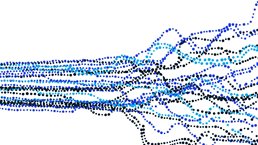More and more companies are choosing to remove the divide between their digital programs and their traditional IT delivery by bringing them into a single technology operating model. Two years ago, just 18 percent of respondents to McKinsey’s global survey of technology leaders said their companies had either converted their digital and IT teams to a single operating model or developed a fully digital model.1 In our most recent survey, that percentage nearly doubled: one-third of respondents say their technology organizations are integrated or fully digital. Sixty-seven percent say their companies aspire to make the shift to an integrated or fully digital technology organization.2
Stay current on your favorite topics
Combining digital operations (in which cross-functional teams apply new technologies and ways of working, such as agile, to improve user experiences) and traditional IT delivery (in which technical specialists develop and maintain core business systems according to traditional methods) has evident benefits. According to survey respondents, companies with an integrated or fully digital technology model are 30 percent less likely than other companies to face digital-transformation challenges and less than half as likely to face issues in integrating new digital efforts with their core architecture. Notably, respondents at companies with integrated digital and IT operations are 60 percent more likely than respondents at other companies to say their companies’ investments in technology create business value.3
Combining digital programs and IT operations is also more practical than other changes that business leaders might consider as part of a digital transformation. Executives sometimes assume that once their digital activities are running well, the next step in their digital evolution should be a far-reaching, potentially disruptive effort to reorganize the entire company and operate it in the manner of a digital native. This needn’t be the case. To achieve the technical agility of a digital native, it is often enough to form integrated, cross-functional technology teams, which define forward-thinking technology organizations.
Moving to an integrated technology operating model does require significant change. Companies can ease the transition by taking three actions: organizing technology teams around user-facing products and the underlying platforms that enable them, creating a governance structure to keep the technology organization focused on the business’s strategic priorities, and establishing a rigorous system for prioritizing and delivering technology work. In this article, we offer a closer look at what these actions involve and how to get them right.
Reorganizing technology teams
To begin integrating digital and IT operations, technology and business leaders should map their companies’ technology activities and assets with respect to two categories: products and platforms (Exhibit 1). Products are the technology-enabled offerings used by customers and employees. Their immediate and primary purpose is to enable users to perform activities that create value, in line with a business’s objectives. For example, a retailer’s search product contributes business value by making it easy for customers to find items on a website or mobile app. Its effectiveness might be measured with conversion-to-sale metrics and enhanced by improvements to search algorithms. An industrial-equipment maker might equip its salespeople with a configuration product that lets them assemble and price orders during customer meetings.

Platforms are the back-end technology capabilities, whether provided by individual systems or by assemblies of multiple systems, that power products, as well as the enterprise more broadly. The retail search product previously described, for example, might rely on an inventory platform that includes databases and integrations with suppliers. Typical platforms found at large companies include those for enterprise resource planning, customer relationship management, inventory management, and field operations.
Many companies launch their digital efforts with a focus on creating and improving products through a stand-alone organization that is separate or siloed from company IT. These separately funded digital units deliver user-experience innovations quickly by employing a mix of design and engineering talent, using cloud technologies, following agile delivery practices, and, often, fostering a different working culture and norms—an approach unlike that of a traditional IT function.
However, it is important that these digital units and IT departments are closely integrated, with thoughtful coordination and planning between the organizations to prevent any bottlenecks. For instance, as digital efforts expand to cover more customer and employee experiences and incorporate new technologies, integration between digital and traditional technology solutions requires more extensive collaboration. Differences in culture and ways of working can make it harder for digital and IT groups to integrate new digital offerings with core systems. Teams from other business functions can also get confused about which technology groups to work with—and how.
Would you like to learn more about McKinsey Digital?
An integrated operating model helps resolve these differences by bringing IT and digital organizations into a single model for planning, delivering, and managing technology, reinforced by a shared culture and talent-management approach. In this model, digital and IT specialists work together on unified teams, each centered on an individual product or platform (Exhibit 2).

Product teams focus on serving the needs of end users in ways that generate revenue, lift productivity, or otherwise directly create value for a company. They operate like minibusinesses, responsible for go-to-market planning, user experience, and adoption in addition to technology delivery. To carry out this approach, product teams include not only engineers but also designers, analysts, and experts from other business functions, such as operations, marketing, and compliance. Typically, they use agile methods to develop products, iterating rapidly to make improvements. Most product teams will have a leader who is more business oriented than technology oriented.
Platform teams focus on making an organization’s core systems accessible, reusable, and modern so that they better enable products. This collaborative approach sometimes calls for platform experts to join product teams temporarily. For example, if the team working on the search product described earlier decides that users should be able to filter their searches on available inventory, then the inventory-platform team might build an API that allows product teams to query inventory data for in-stock items. A platform team will normally adjust its ways of working to match the state of the underlying systems and the needs of product teams and external partners. On most platform teams, the leader will have a technology background, and staff will mainly consist of technology specialists.
An integrated technology organization has two additional components. One is a centralized infrastructure-services team, responsible for provisioning and managing the underlying technology infrastructure in ways that make it efficient, easy to use, reliable, and consistent. By automating activities and promoting standard development, operations, and engineering practices across product and platform teams, the infrastructure-services team continuously streamlines its own work and that of the wider technology organization.
The other is a digital-delivery office, which performs coordinating functions that we describe later in the article.
Of course, the differences between digital programs and IT operations don’t necessarily resolve themselves when specialists from each group combine to form product and platform teams. Indeed, our research suggests that when companies integrate digital and IT specialists, they often find that cultural differences and talent gaps get in the way of effective teamwork.4 In our experience, establishing new operating norms for the integrated IT organization can help align digital and IT employees who have diverging ideas about how their teams should work. For example, technology leaders should lay out a common set of engineering practices as well as standardized ways of working based on agile principles and design thinking.
To address talent gaps, companies often find it necessary to reskill existing employees or hire additional talent. Product teams, for example, handle all aspects of product development, from design to user adoption, so their leaders must be able to understand users, translate their needs into technical requirements, manage product road maps, guide engineering teams, and oversee releases. Few organizations employ enough technology specialists with experience across these disciplines, so they must either train the people they have or bring in new people who have experience as product managers or product owners.
At one omnichannel retailer, the executive team planned the shift to an integrated technology operating model by first identifying potential product teams based on the organization’s digital priorities. The team determined that select personnel from across the company should join these product teams to make them cross-functional. It also set out performance indicators to hold the teams accountable.
Next, executives grouped most of the company’s technology capabilities into platforms. They asked each platform team to prepare a road map for making improvements that would support products while also modernizing the platform’s technology. (Not all platform teams immediately began working in this new way. At first, the retailer focused on those platform teams that provided the most essential functions to high-priority products.) Finally, executives reorganized the leadership of the technology organization to reflect its new structure, in a move we will explore further in the next section. As a result of these changes, the company increased its capacity for delivering the technologies that its strategic priorities called for, and it gained the ability to reallocate people quickly to urgent tasks.

Managing the fallout from technology transformations
Creating a governance model
Each team in an integrated technology organization ordinarily has its own leader. Companies might also appoint a head of products, a head of platforms, and a head of infrastructure services. In addition, integrated technology organizations need a central team, or digital-delivery office, to balance the priorities and resource requirements of product and platform teams and to coordinate any overlapping or related activities, particularly when it comes to prioritizing changes to platforms. Here are some actions that digital-delivery offices can take to govern integrated technology organizations well:
- Define value-focused performance metrics. Defining a few performance metrics for each team, in partnership with business leaders, will help a digital-delivery office tell whether teams are on track. Such metrics should measure both value creation (“Is the team contributing to the business?”) and the delivery of work (“Is the team meeting its commitments?”). For example, the team managing the search product previously described might be assigned a target for increasing the proportion of online searches that convert to sales, in support of a broader strategic goal to lift e-commerce sales.
- Create processes for tracking and reporting. Digital-delivery offices should have consistent workflows for collecting performance updates from product and platform teams (with particular interest in whether business-value and other targets are being met and whether any interdependencies are causing delays) and synthesizing those into reports that can inform a leadership team’s strategic decisions.
- Establish a mechanism for quickly removing bottlenecks and resolving conflicts. Since unexpected difficulties (for example, a dispute between product teams that want to bring in the same platform personnel) can slow down work on technology projects, some organizations empower their digital-delivery offices to come up with quick solutions that minimize delays. Others choose to have their digital-delivery offices surface conflicts to leadership, which resolves them.
- Gradually adopt an agile funding model. It is common for technology organizations to allocate funds for products and platforms on an annual—or even less frequent—basis. By contrast, an agile funding model ties new releases of funding to the achievement of development or performance objectives. This approach keeps teams focused on delivering value and prevents companies from backing struggling initiatives merely because funds were already allocated to them. With respect to the search product mentioned before, the team might receive initial funding to create and test a new function but only receive full funding to develop and launch the function if user tests show that the new function increases the likelihood of sales conversions.
One global consumer company set up a digital-delivery office to facilitate the development of new digital products for customers after noticing that too many products had fallen behind schedule. At the outset, the company’s executive team set goals that defined what the success of these products would look like, including specific changes to customer experience, geographic coverage, and value-creation metrics. The digital-delivery office tracked the technology organization’s progress against these goals and held monthly reviews with executive leaders. It also tracked leading indicators and surfaced early signs of problems in areas such as software quality and reliability. To resolve those problems, the office established a weekly leadership forum and series of meetings to escalate issues spotted by engineering teams. As a result of these efforts, the company accelerated the development of several products that had been delayed and launched them sooner than it had planned.
Establishing a system to prioritize and deliver technology work
Even though technology teams and roles might be well defined, coordinating their many activities can be difficult. Leaders should therefore create a system for maintaining order in how product and platform teams respond to the business’s demand for technology services.
One feature of this system should be processes by which a technology organization aligns product and platform road maps with the business’s priorities. The head of each business function should have a single contact within the tech organization, likely a product manager or user-journey lead, who is responsible for understanding the function’s priorities and translating them into a set of desired technology features, recorded on product backlogs. Product managers then work with their platform-team counterparts on updating the platforms’ development road maps to incorporate the features that products require. (Functional leaders should also assign their personnel to product teams when necessary to speed development.) The digital-delivery office then helps sort out project, staffing, and other priorities across multiple teams, consulting with the organization’s leadership when conflicts have strategic implications (Exhibit 3).

The digital-delivery office also helps manage the dependencies among teams, particularly product teams’ dependencies on platform teams. Product and platform teams can do some of this on their own. Earlier in the article, we noted that a retailer’s online search product might depend on an underlying inventory platform. In such a case, the search-product team and inventory-platform team would ideally work together to ensure that changes to the inventory platform are in sync with the release plan for the search product. But because each platform supports multiple products, and each product depends on multiple platforms, coordinating development efforts across teams can get complicated. To minimize conflicts and surprises, every dependency should be addressed on at least one team’s release plan.
The digital-delivery office should also make sure that product teams depend on platform teams but that platform teams never depend on product teams. The idea is to prevent any one product team from restricting the work of a platform team because that can interfere with what other product teams want to do. The one-way nature of dependencies between products and platforms might require product teams to postpone the release of certain features while platforms are being updated and to fast-track other features in the meantime.
The digital-delivery office helps manage dependencies by reviewing each team’s road map to identify the impacts of any planned changes. It also holds regular meetings with product and platform leaders to go over the value and feasibility of the features they want to add, identify new dependencies, and negotiate teams’ competing interests (such as product teams’ needs to borrow the same personnel from platform teams and product teams’ simultaneous requests for additional platform features). Some digital-delivery offices establish a common release cadence so that they can more easily coordinate assignments of resources. Other practices, such as feature flagging, can prevent dependencies from delaying releases.
Last, integrated technology organizations should look for and seize opportunities to modernize IT products and platforms as they are working on requests from the business for new features and solutions. For platform teams, especially, modernizing core systems in the course of their normal work ensures that the platforms remain capable of meeting increasingly sophisticated technical requirements from product teams. Platform teams should also reserve capacity to ensure that any changes are exposed in as-a-service offerings for all product teams to use (through an API endpoint, for example). This approach not only ensures that changes to platforms support multiple products without adding duplication or complexity but also allows product teams to build new capabilities without always engaging platform teams.
Increasingly, companies are choosing an IT operating model that integrates customer- and employee-facing digital efforts with the activities of conventional IT departments and promotes uniform approaches to technology work. By forming integrated teams to support products and platforms, instituting consistent governance processes, and establishing a common system for prioritizing work, a technology organization can increase the value it creates for a business.


